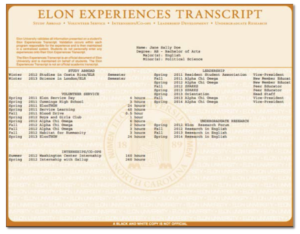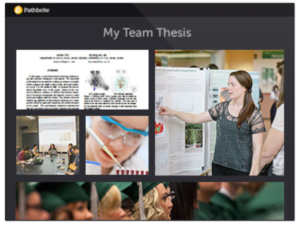A growing number of colleges are allowing students to uses opportunities outside the classroom to enhance and validate classroom knowledge. The registrars at these institutions are documenting this information on the official transcript to better communicate the student’s comprehensive academic experience from these opportunities. The main benefit is that the enhanced or experiential transcripts are maintained, certified and issued by the institution. This provides a higher level of validity but can also highlight a linear relationship between academic and outside experience as a student moves through their college experience. Colleges reason that verified academic and experiential activities combined in a single document differentiate a student when applying to graduate programs or when providing information to a prospective first time employer.
Another name for the experiential transcript is a co-curricular transcript. There are also competency-based and data-enabled transcripts. All of these types offer more information than that found on the standard academic transcript and come with the official stamp of the registrar. A criticism of these types of transcripts is that they may not be comprehensive, capturing all extracurricular activities or providing enough context as to how the student has benefited. And given that the goal is to provide a view of the total college experience, the means by which the total experience is presented is in a format that remains unchanged from what was mailed out 3 decades ago.
Experiential transcript example:

A number of other commercial applications have been created for the same purpose in that they provide a means to showcase both academic and non-academic experiences and achievements. These applications can fall into a handful of broad categories termed eportfolios, experience infographics, or digital lockers. Differing from the transcript type, these applications make it the responsibility of the student to curate, organize and present the end product. Digital portfolios and infographic types of applications let the student integrate different multimedia (e.g. video, audio, blogs, images, etc.), along with text to present their academic or work experience in a rich, dynamic, ordered, online format. While these applications are not typically an official document from the college they can provide a visually engaging account of the academic or work experience when submitting information to graduate admissions personnel or applying for employment.
Electronic Portfolio Example:

The increase in colleges offering the types of transcripts and growth in the companies offering visual resumes highlighted above is in direct response to a shift in how post-secondary education is evolving and being delivered, as well as an indicator that many employers are now looking for a demonstration or proof of skills and ability before investing one-on-one time with candidates.
If your student is at a college that has the infrastructure for reporting and validating non-academic activities, they still need their own tools and process to capture the multitude of outside the classroom academic work, extracurricular activities and the achievements and accomplishments that have been garnered throughout their journey. Most students rely on memory, reviewing past social network posts or calendar entries to reconstruct the time commitment and details surrounding important milestones. Without a tool and a process a student risks having missing or incomplete information, or inaccurate reporting on specific activities.
If captured in the right manner, this information can be used to provide context to the flat list format of the experiential transcript, or as a source of stored artifacts to feed into a commercial eportfolio application. The ancillary value of consistently documenting non-classroom activities is the mindfulness and understanding gained when viewing the relationship between the effort and outcomes over time. This may in fact serve as the greatest benefit leading up to the point when the information is needed for graduate applications and employment opportunities.
